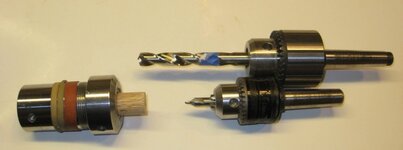sequoia
Member
Hi All,
I have been waiting to ask this question for a while. It was actually the reason why I searched for a forum like this. I have been trying to figure out a way to make sure I drill a hole down the center of my blank without it wandering off center on the opposite side of the blank. Sometimes the other side of the blank has a hole that is so close to the edge of the blank (way off center).
This has been happening to me, especially on narrower blanks (1/2 inch or so). At first I thought it was my drill press so I tried to use a chuck with pen jaws and a drilling chuck on the tail stock and it happened there as well.
I'm sure I am missing something very basic. I try to make sure the drill press platform is level and perpendicular to the drill bit. I use a cheap drill press vise that I clamp down to the table and try to get the pen blank plumb using a small level before starting to drill.
The fact that it is happening on a lathe as well leads me to believe I might be taking something for granted or missing something very obvious.
Any suggestions or tips would be appreciated,
Matt
I have been waiting to ask this question for a while. It was actually the reason why I searched for a forum like this. I have been trying to figure out a way to make sure I drill a hole down the center of my blank without it wandering off center on the opposite side of the blank. Sometimes the other side of the blank has a hole that is so close to the edge of the blank (way off center).
This has been happening to me, especially on narrower blanks (1/2 inch or so). At first I thought it was my drill press so I tried to use a chuck with pen jaws and a drilling chuck on the tail stock and it happened there as well.
I'm sure I am missing something very basic. I try to make sure the drill press platform is level and perpendicular to the drill bit. I use a cheap drill press vise that I clamp down to the table and try to get the pen blank plumb using a small level before starting to drill.
The fact that it is happening on a lathe as well leads me to believe I might be taking something for granted or missing something very obvious.
Any suggestions or tips would be appreciated,
Matt

